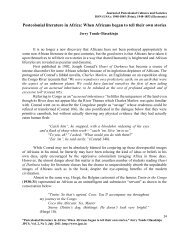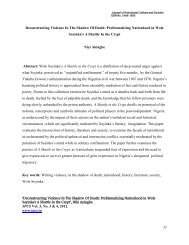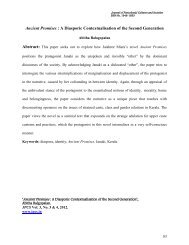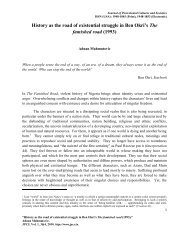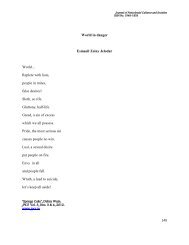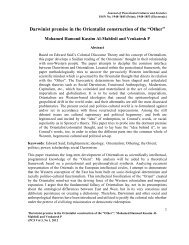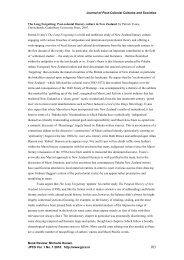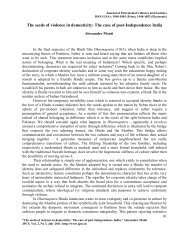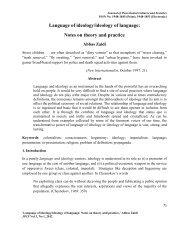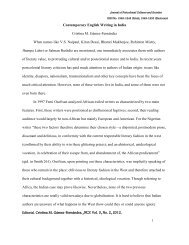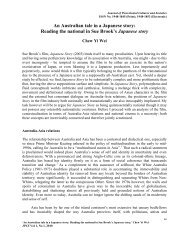'Crossing Thresholds': Radical Notes in Women's Writings ... - JPCS
'Crossing Thresholds': Radical Notes in Women's Writings ... - JPCS
'Crossing Thresholds': Radical Notes in Women's Writings ... - JPCS
Create successful ePaper yourself
Turn your PDF publications into a flip-book with our unique Google optimized e-Paper software.
Journal of Postcolonial Cultures and SocietiesISSN No. 1948-1845 (Pr<strong>in</strong>t); 1948-1853 (Electronic)A few years after the Angare fracas and the furor over Rashid Jahan‘s gendered<strong>in</strong>subord<strong>in</strong>ation, Ismat Chugtai‘s story ‗Lihaf‘(The Quilt)created another controversy bypresent<strong>in</strong>g what was considered as ―the most suggestive and sensual representations ofhomoeroticism <strong>in</strong> modern Indian fiction‘ (Gopal 64). Neglected by an aristocratichusband who prefers to spend time with beautiful young men, a young bride Begum Janf<strong>in</strong>ds physical and emotional fulfillment <strong>in</strong> her maid. The quilt that covered the twowomen and threw mov<strong>in</strong>g shadows on the wall functioned as a trope for the rework<strong>in</strong>g ofwife‘s oppressive conditions, first <strong>in</strong>to survival and then fulfillment. In 1998, a similartheme was explored <strong>in</strong> Canadian filmmaker Deepa Mehta's controversial film, Fire <strong>in</strong>which the marital crisis of the two sister-<strong>in</strong>-laws Radha and Sita , who end up <strong>in</strong> draw<strong>in</strong>gmutual sustenance <strong>in</strong> a same sex relationship , are resolved through homoerotic pleasure.Lesbianism, therefore, unlike its Western reflection, takes on the connotations of anunequal power relationship, which the two women set out to equalise through their sexual<strong>in</strong>timacy without men.In this paper I have <strong>in</strong>cluded writ<strong>in</strong>gs across the genres by ‗home writers‘ from with<strong>in</strong> theIndian Subcont<strong>in</strong>ent such as, Kamala Das, Mahasweta Devi Saroop Dhruv from India,Kishwar Naheed and Fahmida Riaz from Pakistan, and Taslima Nasr<strong>in</strong> from Bangladesh .Thus, we have a poem by Kamala Das, a short story by Mahasweta Devi, an extract ofprose writ<strong>in</strong>gs of Nasr<strong>in</strong> , and poems by the Pakistani writers .Renowned Indian poet and writer Kamala Das from India, who triggered controversyboth <strong>in</strong> her writ<strong>in</strong>g and her lifestyle, wrote <strong>in</strong> English and Malayalam, the language ofsouthern state of Kerala. The w<strong>in</strong>ner of several national and <strong>in</strong>ternational literary awards,Das wrote frankly and explicitly about sexuality, often outrag<strong>in</strong>g orthodox readers. Herwrit<strong>in</strong>gs most often focused on love and betrayal. Written <strong>in</strong> a confessional mode,Kamala Das‘s poem ―An Introduction‘ , a frequently anthologized piece, depicts her as arebellious poet who searches for cultural-l<strong>in</strong>guistic as well as sexual identity <strong>in</strong> a postcolonialreality whish is so oppressive and overbear<strong>in</strong>g. The first few l<strong>in</strong>es of her poem‘Cross<strong>in</strong>g thresholds: <strong>Radical</strong> notes <strong>in</strong> women’s writ<strong>in</strong>gs from contemporary South Asia,’Madhu S<strong>in</strong>gh<strong>JPCS</strong> Vol 2 No 4, December 201185



